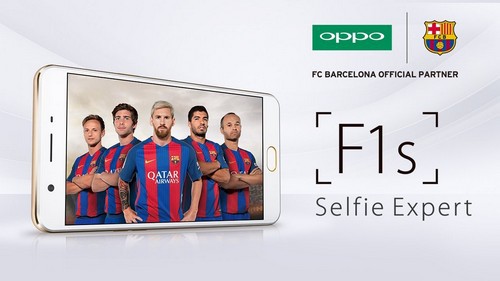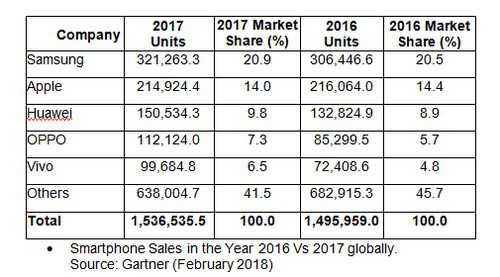Commonly referred as Oppo, the Chinese manufacturer Oppo Electronics Corporation is the producer of Smartphones, electronic devices, and Bluray players. It is a subsidiary of Guangdong Bubugao Electronic Industry Co. Ltd., which is the manufacturer of Vivo, One plus, and other electronics items. The BBK electronics is the world’s 2nd largest smartphone manufacturer i.e. behind only Samsung in the year 2017.
Oppo has made its name as selfie & group selfie expert technology and has been ranked 4 for creating the selfie experiences among the young generation globally. Some of the smartphone models of the brand are Oppo F series (F1, F3, F5 and F7), Oppo A series and Oppo R series.
Table of Contents
Segmentation, targeting, positioning in the Marketing strategy of Oppo–
Focusing on the technological breakthrough from last 0f years the brand started the business by segmenting the business based on the technologies it uses for the particular group of customers i.e. millennial who have just started earning or are in college. By doing this they have used selective targeting strategy i.e. only making products for the select type of customers rather one fits for all.
The company has positioned itself on the basis of the state of the art image capturing and processor technology working on aesthetic part of the quality photos.
Marketing mix – Here is the Marketing mix of Oppo.
SWOT analysis – Here is the SWOT analysis of Oppo.
Mission-“ Not Available”
Vision- “Not Available”
Tagline-“Enjoyed by Young People Worldwide”
Competitive advantage in the Marketing strategy of Oppo–
Technological Advancement: Whether it is the blazing fast technology of Oneplus or the artificial intelligence enabled front camera starting the selfie beautification revolution. The company has been successful in short period of time to create visibility and top of mind awareness in the targeted segments.
Chinese Parent Company: The brand Oppo is the part of Chinese Company with 9000+ employees helping in distributing the smartphones of the brand in more than 31 countries globally. The Parent company is specialized in digital cameras, electronic items, Television sets, and headphone amplifiers.
BCG Matrix in the Marketing strategy of Oppo-
It has been operating with two major business segments i.e. Oppo and OnePlus Smartphones.
Are oppo smartphones quite picking up on the market with the price segment of? 10000/- onwards and with the market share of 3 % in the year 2017.
While the demand of the Oneplus smartphones has been increasing exponentially with the success of Oneplus 5T, its availability on the online platform Amazon and with the promotion of Oneplus 6 receiving good response from the market the future prospect is positive for the company. The brand has 4.3 % market share in 2017.
Oppo smartphones are still fighting with the rivals such as Xiaomi and Huawei and therefore is the question mark in the BCG matrix. Oneplus smartphones are Star in the BCG matrix.
Distribution strategy in the Marketing strategy of Oppo-
The brand has been distributing its products through various channels such as Retailers, distributors, wholesalers, e-commerce websites and brick & motors stores like single-brand Retail outlets which recently the company has got the license in India.
The brand has opened more than 200 stores in India and is planning to open more exclusive stores globally. Additionally, it has been distributing its offerings through the exclusive tie-up with e-commerce giants Amazon and Flipkart.
Brand equity in the Marketing strategy of Oppo–
The Chinese brand is promoted and marketed by BBK Electronics, the parent company of the brand. The company has been aggressively promoting the brand as selfie expert in order to capture the aspiration and imaginative space in the mind of the consumers.
The brand along with its sister concern Vivo is committed to the Indian & Asian market, the biggest market for the duo.
Oppo has been leveraging the two crazy attractions of the Indian market i.e. Cricket and Bollywood to engage with the vibes of the young generation.
Competitive analysis in the Marketing strategy of Oppo–
Contrary to established companies in the market which focuses on all segments from entry-level mobiles to medium and high-end mobiles, the Oppo has been designing the offerings with high-end specifications at low prices with its flagship brands Oppo and Oneplus.
Both have been successful in increasing its market share from 5.7% in the year 2016 to 7.3% in 2017. It competes with companies such as Xiaomi, Samsung, Micromax, Huawei, Apple and its sister concern Vivo.
Market analysis in the Marketing strategy of Oppo–
Increased number of flagship products of peer brands, shrinking margins, Chinese product perception of customers, competition in the industry, backend integration with the suppliers are some of the factors which are affecting the market presence of the brand Oppo.
The brand has been doing product and technology development to target the niche segment and technologies like Color OS, photography technology are helping it in staying ahead of the other brands in the market and at the same time increasing its market share over the years.
Customer analysis in the Marketing strategy of Oppo–
The customer of the brand is the young millennial in the age group of 15-40 years and from middle and upper-middle-class income group.
These customers are more inclined towards the technological advancement in their personal devices and sometimes flaunt it in their social groups. Customers don’t believe in the long-lasting usage of Smartphone devices but believe in being tech savvy and technologically ahead in the market.
Liked this post? Check out the complete series on Strategies


Your article is quite helpful and of great use for my Marketing class. Thanks :)